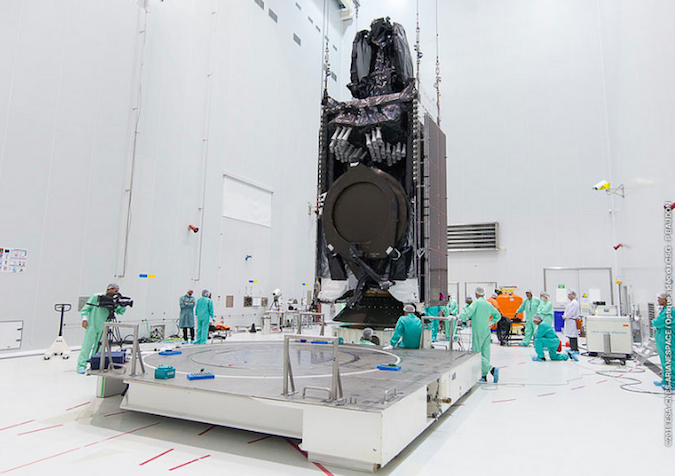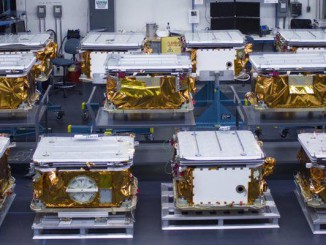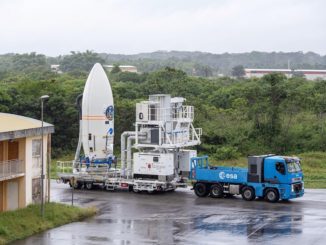
Launch managers in French Guiana on Monday approved plans to loft two U.S.-built communications for Intelsat aboard an Ariane 5 rocket Wednesday.
The launch readiness review Monday gave the “go” for launch after officials received briefings on the status of the Ariane 5 launcher, its two Intelsat satellite passengers, and a network of ground facilities from French Guiana to Africa needed to support the flight.
The 45-minute launch window opens at 5:55 p.m. EDT (2155 GMT; 6:55 p.m. French Guiana time) Wednesday for the fourth Ariane 5 mission of the year, and the 87th overall.
Rollout of the 180-foot-tall (55-meter) rocket is scheduled for Tuesday morning. A specially-designed 540-horsepower Titan tug with high-precision steering will pull the Ariane 5 out of the final assembly building at the Guiana Space Center and tow the rocket and its mobile platform along rails for the 1.7-mile (2.7-kilometer) journey to the ELA-3 launch zone.
Once the Ariane 5 arrives at the pad, workers will connect the rocket with the facility’s propellant, electrical and communications systems. The first stage’s tank of liquid helium pressurant will also be filled Tuesday afternoon, ahead of the start of the final countdown early Wednesday.
The process to fuel the rocket’s two main stages with liquid hydrogen and liquid oxygen will begin about five hours before liftoff. The Ariane 5’s two strap-on boosters are already filled with their pre-packed solid propellant.
The Intelsat 33e and Intelsat 36 satellites are mounted atop the Ariane 5 rocket for Wednesday’s flight, which will put both craft into an egg-shaped geostationary transfer orbit ranging in altitude between 155 miles (250 kilometers) and 22,294 miles (35,879 kilometers).
The two satellites, along with the Ariane 5’s Sylda adapter to accommodate them, weigh a combined 23,666 pounds (10,735 kilograms), according to Arianespace.
Each satellite will circularize its orbit at an altitude of nearly 22,300 miles within a couple of weeks of launch. At that altitude, their speed will match the rate of Earth’s rotation, giving the satellites views of the same part of planet all the time.
Intelsat 33e, manufactured by in El Segundo, California, by Boeing, is the second in a series of modernized high-throughput “Epic” communications satellites for Washington-based Intelsat. Featuring a fully digital payload, the spacecraft will beam C-band and Ku-band services for mobile telecom operators, television broadcasters, and broadband providers across Europe, Africa, the Middle East and the Asia-Pacific region.
Intelsat intends to park the Intelsat 33e satellite along the equator at 60 degrees east longitude for a 15-year mission.
Riding in the upper berth inside the Ariane 5’s nose cone, Intelsat 33e will deploy first after the rocket’s second stage turns off. The mission’s co-passenger, Intelsat 36, is smaller and will launch in the lower position in the Ariane 5’s Swiss-made fairing.
Intelsat 36 was built by Space Systems/Loral in Palo Alto, California. It is destined for a slot in geostationary orbit at 68.5 degrees east longitude, where the satellite will position itself near the Intelsat 20 satellite already in space to deliver direct-to-home television programming to Sub-Saharan Africa and broadcast video to cable customers across South Asia.
Email the author.
Follow Stephen Clark on Twitter: @StephenClark1.



